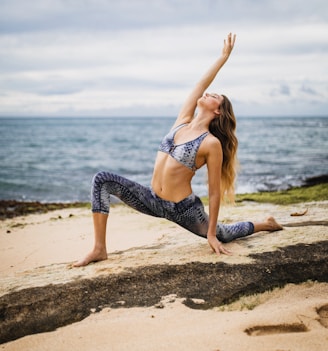The Importance of Stretching Before and After Exercise
Learn why incorporating stretching into your exercise routine is crucial for preventing injuries and improving flexibility. Discover effective stretching techniques and tips for maximizing your workout.
STRETCHING
8/13/20234 min read


Learn why incorporating stretching into your exercise routine is crucial for preventing injuries and improving flexibility. Discover effective stretching techniques and tips for maximizing your workout.
Incorporating stretching into your exercise routine is crucial for several reasons, including preventing injuries, improving flexibility, and maximizing the benefits of your workout. Stretching helps prepare your muscles and joints for physical activity, enhances your overall performance, and contributes to your long-term well-being.
Importance of Stretching:


Injury Prevention: Regular stretching helps increase the flexibility and range of motion of your muscles and joints. This can reduce the risk of strains, sprains, and other exercise-related injuries.
Muscle Recovery: Stretching after a workout can aid in muscle recovery by promoting blood flow and reducing muscle soreness.
Improved Flexibility: Stretching over time can lead to improved flexibility, making it easier to perform various movements and activities with greater ease.
Enhanced Performance: Properly stretched muscles can generate more power and efficiency during exercise, leading to improved athletic performance.
Posture and Balance: Stretching can help improve your posture and balance by releasing muscle tension and promoting proper alignment.
Mind-Body Connection: Incorporating stretching into your routine provides an opportunity to connect with your body, increase body awareness, and promote relaxation.
Stretching is an essential part of any exercise routine. It helps to increase flexibility and range of motion, which can improve overall performance and reduce the risk of injury. Stretching also helps to relieve muscle tension and soreness, allowing for faster recovery after a workout. It is important to stretch both before and after exercise to warm up the muscles and prevent tightness. Regular stretching can also improve posture, enhance muscle coordination, and increase blood flow to the muscles. Incorporating stretching into your daily routine can also promote relaxation and reduce stress. Whether you are an athlete, a regular gym-goer, or simply someone looking to improve your overall fitness, stretching should not be overlooked.
Effective Stretching Techniques:
Dynamic stretches involve active movements that take your body through a range of motion. They are best used as a warm-up before exercise to increase blood flow and prepare muscles for activity.
Examples: Leg swings, arm circles, hip circles, and walking lunges.
Dynamic Stretching:
Static Stretching:
Static stretches involve holding a stretch in a comfortable position for a set period (usually 15-60 seconds). This type of stretching is best done after your workout to improve flexibility and cool down.
Focus on major muscle groups like hamstrings, quadriceps, calves, chest, back, and shoulders.
PNF Stretching (Proprioceptive Neuromuscular Facilitation):
PNF stretching combines stretching with contracting and relaxing muscles. It's often done with a partner but can also be done individually.
This technique is particularly effective for improving flexibility.
Active Isolated Stretching (AIS):
AIS involves stretching a muscle for 1-2 seconds, then releasing and repeating. It is thought to be less likely to trigger the stretch reflex, allowing for greater flexibility gains.
Integrating effective stretching techniques is crucial for preventing injuries and enhancing your fitness journey. Stretching improves flexibility, range of motion, and muscle readiness. This guide introduces essential methods – dynamic and static stretching, PNF, and AIS – to optimize workouts and foster better recovery. Whether you're a beginner or an experienced athlete, mastering these techniques ensures a safer and more rewarding exercise experience.
Tips for Maximizing Your Stretching Routine:
For an effective stretching routine, warm up beforehand, breathe mindfully during stretches, progress gradually to avoid strain, be consistent in your practice, balance both sides of your body, stay hydrated, listen to your body's cues, and consider using props for proper alignment and form. Following these tips will optimize your stretching routine, promoting flexibility and overall well-being.






Warm Up First:
Breathe:
Gradual Progression:
Consistency:
Focus on Balance:
Stay Hydrated:
Listen to Your Body:
Use Props:
Always perform a light cardiovascular warm-up before static stretching to increase blood flow to your muscles.
Maintain slow, deep breaths while stretching to help relax your muscles and increase your range of motion.
Avoid pushing yourself too hard into a stretch. Gradually increase the intensity to a point where you feel mild tension, not pain.
Incorporate stretching into your routine regularly, ideally after each workout.
Proper hydration supports muscle function and flexibility.
Stretch both sides of your body equally to maintain balance and symmetry.
If you feel pain or discomfort, ease off the stretch. Stretching should never cause pain.
Yoga blocks, straps, and foam rollers can aid in achieving proper alignment and depth in your stretches.
Remember that flexibility gains take time, so be patient and consistent with your stretching routine. By incorporating stretching into your exercise regimen, you'll not only reduce the risk of injuries but also enhance your overall physical performance and well-being.